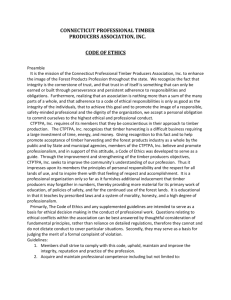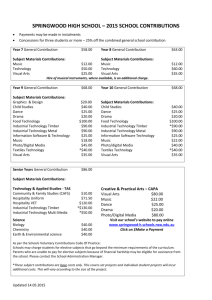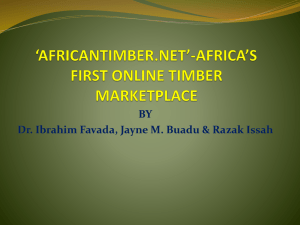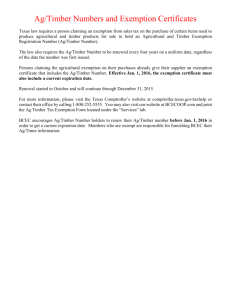Outline for Mr. Bradley's presentation.
advertisement
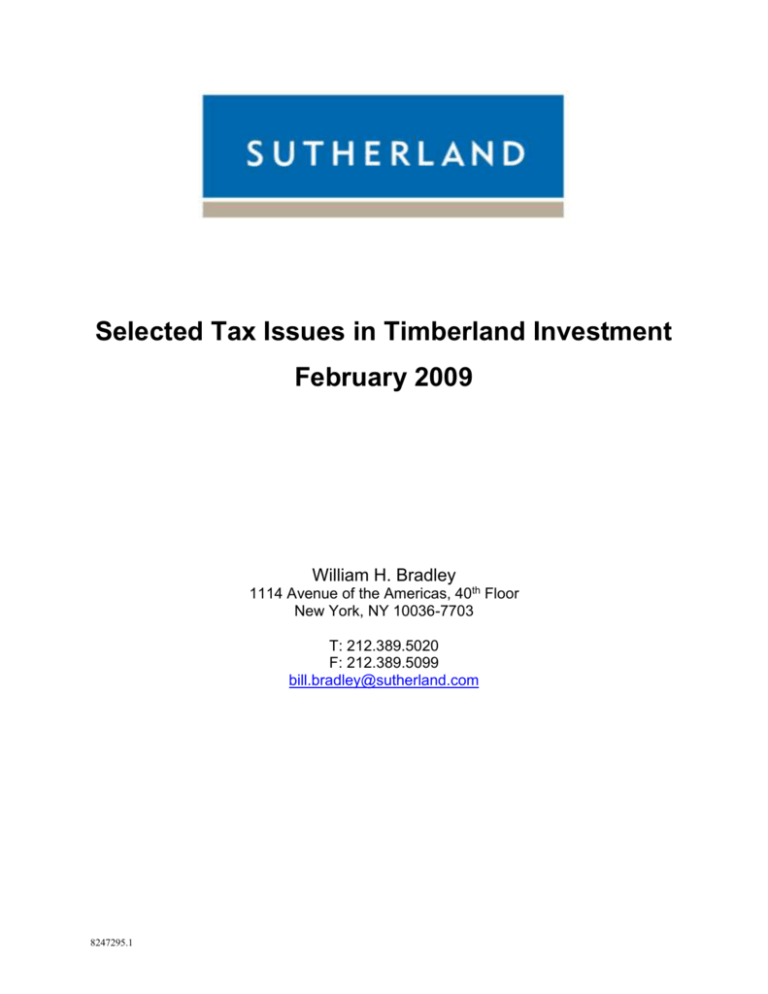
Selected Tax Issues in Timberland Investment February 2009 William H. Bradley 1114 Avenue of the Americas, 40th Floor New York, NY 10036-7703 T: 212.389.5020 F: 212.389.5099 bill.bradley@sutherland.com 8247295.1 Survey of Selected Tax Issues in Timberland Investment I. Key Tax Issues in Structuring Timberland Investment A. II. 8247295.1 Why it matters 1. Special capital gain provisions for timber dispositions adopted in 1943 as a war measure to encourage reforestation; at the time there was an “excess profits” tax on corporate income, and both corporate and individual ordinary rates could reach 90%. Timber owners made the case that they could not afford to re-forest, and wait a full rotation for additional income, if they were taxed at ordinary rates. 2. Fundamental issue is that, in general, routine disposition of “inventory” type items—similar to annual sales of standing timber— produce ordinary income, not capital gain. Same is true of a disposition with a “retained economic interest”—this is not really a “sale,” but instead is a royalty. When McDonald’s allows franchisees to use the McDonald’s Golden Arches on napkins in return for a payment, it hasn’t “sold” the rights to the Golden Arches; instead it has entered into a royalty arrangement. The same is true when a timber owner grants a buyer the right to come on the land and cut trees, in exchange for a payment based on volume removed. 3. Tax differences, and relative tax burden, are crucial to attracting capital to one form of investment or another. Methods of Timber Disposition A. 631(a)—Owner harvests the timber and either sells the cut logs or uses them in its own business. This is a “mark to market” provision—difference between fmv of the standing timber and basis on the first day of the year in which it is cut is capital gain or loss; the cut log then enters inventory at its 631(a) value, and any further gain or loss from cut and haul, and from merchandising, is ordinary. B. 631(b)—Owner does not cut, but either sells standing timber “outright” or through a cutting contract in which the owner has a “retained economic interest” in the timber. C. Timber “lease”. These used to be common throughout the South. The forest products company would pay the land-owner annual rent for the right to harvest trees on the land-owner’s property. They have spawned a good bit of litigation, both between land-owners and forest products companies, as the land-owners have sought to break the leases, and between the land-owners and the IRS, as the land-owners have tried to claim that the leases really qualified as 631(b) dispositions. In general, they didn’t, because the lease payments were not based on volumes actually removed. Therefore the land-owner was stuck with ordinary income. D. III. Special Tax Issues in Timber Operations A. 8247295.1 Outright Sale of Timberland. Such sales raise the “dealer” issue and special issues for the foreign investors, both discussed later. Recovery of basis through “depletion” 1. First step in an acquisition of timberland is to allocate basis between land and timber, and, in the “land” account, between core timberland and identifiable HBU properties, and other special use property such as mines. 2. Use of concept of timber “block” and timber “account” in allocating basis of timber. 3. Opportunity to increase depletion in early years through either subdivision of a large tract into numerous sub-accounts and assigning greater portion of basis to areas that will be cut soonest, or, depending on facts, aggregating high basis timber that will not be cut immediately with low basis timber that is scheduled for immediate harvest. B. Casualty Loss and Limitations. Code section 165 allows a current deduction for any loss sustained during the taxable year and not compensated for by insurance of otherwise. But the amount of the loss is limited to the “single, identifiable property” or “SIP” that is destroyed. Pursuant to Weyerhaeuser v. U.S., a 1996 case decided by the Federal Circuit, the SIP is the entire timber tract in which the damaged trees were growing, and not, as contended by the IRS, to the basis for depletion of the trees actually destroyed. This illustrates a crucial issue in selecting a depletion block: multiple small blocks may increase depletion in the early years, but will also limit the casualty loss deduction if something goes wrong. C. The “Dealer” Issue. The question is whether the timber owner is holding the property primarily for sale to customers in the ordinary course of a trade or business. If so, the gain or loss is ordinary, instead of capital, to a taxable investor; it is taxable at full ordinary rates, instead of being untaxed, to a tax-exempt investor, and it is a “prohibited transaction” subject to a 100% tax to a REIT. There are few bright lines; but most important is the number and frequency of sales. Also, if the owner improves the property in any way, such as by arranging favorable zoning, it may become dealer property. Solution may be to sell the property in bulk to a taxable subsidiary, which can then subdivide and improve as necessary. D. E. Like-kind exchange transaction. 1. Must be property held for productive use in a trade or business or for investment; “dealer” property not eligible. 2. “Deferred” and “3-party”exchange technique essentially allows owner to sell for cash, and then re-invest, provided replacement property is identified within 45 days and exchange is completed within 180 days. Form of Investment Entity 1. Pass-thru Entities—Partnership, LLC or REIT 2. Look-thru Entities—Partnership and LLC; a REIT in one case 3. C-Corp—the demise of the “integrated” forest products company 4. What is a REIT and when to use it? a. A REIT is C-Corp that can deduct dividends, thereby substantially eliminating the double tax b. Must meet strict asset and income tests—in general assets are limited to real estate, and income must be derived from real estate activities c. Because a REIT is a C-Corp, it provides a “shield” or acts as a “blocker” and trade or business activities of the REIT, and debt incurred by the REIT, are not attributed to the REIT shareholders. Important for tax-exempt and foreign investors. d. A REIT generally must distribute 90% of income annually, but may elect to retain capital gain. F. Special Issues for Investors 1. The Tax-Exempt Investor and UBTI a. UBTI is “Unrelated Business Taxable Income”—that is income earned by the exempt organization from the conduct of a business activity that is unrelated to its charitable purpose. General rule is that capital gains, because they generally arise from 8247295.1 investment activities, do not generate UBTI. But what about gains from disposition of standing timber, which is a recurring activity, similar to “dealer” sales. b. Timber Harvest Issues—Income derived from 631(b) cutting contracts—which are essentially royalty agreements that are treated “as though they were” a sale or exchange. A special rule in section 1231 treats these sales as generating capital gain, and, because of their passive nature the IRS has ruled that they do not produce UBTI. Income derived by a timber owner from cutting timber and selling the cut logs, on the other hand, is treated as being derived from an active trade or business and is therefore subject to UBTI, even though, under section 631(a), it is taxed as capital gain. c. From Leverage—Income derived from “debt-financed” investment also generally produces UBTI. There is an important exception for qualifying “acquisition indebtedness” incurred by a pension fund or an educational institution. The exception does not extend to other endowments or to private foundations. A REIT, however, acts as a “blocker” because, unlike the situation with a partnership or an LLC, debt incurred by the REIT is not attributed to the unit holders. d. From land sales—the dealer issue. Distinction between HBU sales and liquidating distributions 2. The Foreign Investor and U.S. Income Tax a. FIRPTA and its application. In general, a foreign investor that is not engaged in a U.S. trade or business is not taxed on U.S. capital gains. But FIRPTA creates a presumption that the foreign investor in U.S. real property is engaged in a U.S. trade or business, and that the gain from the sale of such property is “effectively connected” with that trade or business, resulting in U.S. tax on the transaction. b. Participation as a Partner. Code section 875 provides that a non-resident alien individual or foreign corporation shall be considered as engaged in a trade or business in the U.S. if the partnership of which such individual or corporation is so engaged. This means, for example, that a foreign limited partner or a nonmanaging member of an LLC is presumed to be engaged in the trade or business of the partnership or LLC. c. Participation as a REIT Shareholder. Section 897(h) of the Code contains an exception to the general rule that a REIT is not a 8247295.1 “look-thru” vehicle by treating distributions from the REIT that arise from dispositions of a U.S. real property interest as subject to FIRPTA. d. Question: are proceeds from a cutting contract for standing timber attributable to the disposition of a U.S. real property interest? e. Sale by a foreign investor of shares in a “domestically-controlled” REIT not subject to U.S. tax; broader exception for sales of a publicly traded REIT. IV. Sales Techniques A. B. 8247295.1 Installment Sales. General rule is that gain on a sale is recognized if the seller receives either cash or a note. Installment sale rule is a tax accounting provision that provides an exception: When the buyer issues a note in payment for property, gain recognition is deferred until the seller receives payments on the note. 1. General rule of interest on deferred tax liability 2. General rule that a pledge of installment note (to secure immediate cash) triggers gain 3. Exception for “farm property” 4. Structure of installment sale deals Taking Advantage of the TREE Act



